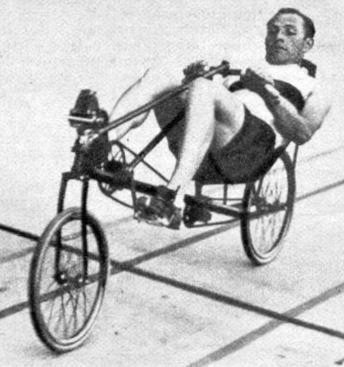Entries in Gen Bike History (53)
The Quest to be the Fastest Cyclist in the World
 Thu, August 7, 2008
Thu, August 7, 2008 
The picture above is from 1937. It shows Frenchman Albert Marquet setting a motor paced speed record of 85.3 mph. (139.9 kph.) Drafting behind a Cord car that has been rigged with box like structure behind the rear bumper.
A crude fairing made of fabric appears to be tucked into the rear doors; also note the extended exhaust pipe. The event took place in Los Angeles, California; I guess traffic was a lot lighter in 1937.
The quest to be the fastest cyclist in the world began in 1899 when Charles M. Murphy rode his bike behind a train on the Long Island Railroad, at Farmingdale. He covered a measured mile in 57.8 seconds (60 mph.) and from that day became famous Nationwide, known as “Mile a Minute Murphy.”
To achieve this feat, approximately three miles of wooden boards were laid between the railroad tracks to give Murphy a smooth surface to ride on. He was hauled aboard the pace coach by helpers, just before the track ran out, his feet still strapped to the pedals of his bike.
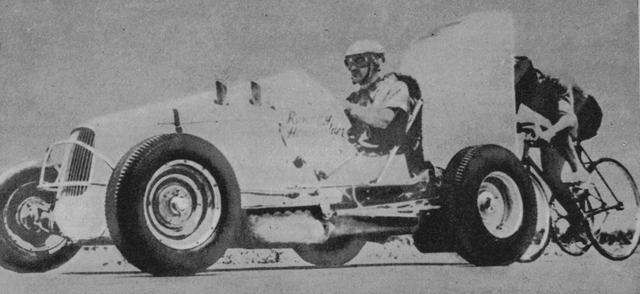
The next picture (Above.) shows Alf Letourner behind his pace car. On May 18th, 1941. Once more in California, near Bakersfield. Letourner set a new bicycle speed record of 108.92 mph. Note the size of his chainring, so large it almost touches the ground.
Forward to July 20th, 1985 when John Howard set a new motor paced bicycle record of 152.2 mph on the Bonneville Salt Flats, in Utah. This is the same John Howard who was on the US Olympic team, won the Ironman Triathlon in 1980, and marketed a line of bicycle frames I built under his name in 1983.
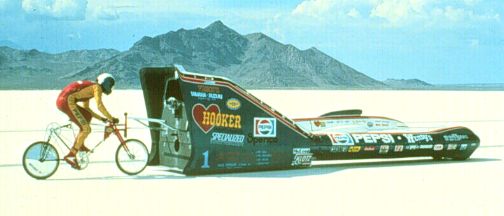
Unlike the previous riders mentioned here who, with the exception of the massive required gearing, rode pretty standard track bikes. John however, rode a purpose built machine, built by Texas framebuilder, Skip Hujsak.
As I remember, John had this bike made for a previous attempt on this record, before 1983 when I first met him. He brought this bike to my shop sometime that year. It had a very long wheelbase for stability, the most noticeable feature was the two stage gearing.
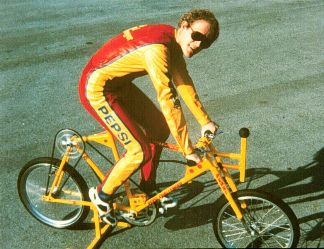
The chainwheel mounted on the left side drove a sprocket on a counter-shaft behind the saddle and above the rear wheel. A chainring on the opposite side drove the rear wheel sprocket. The wheels were, I think, were some high performance BMX wheels, probably the strongest available at the time.
John also wore some serious safety gear, a full length, one piece, leather suit and a motorcycle helmet with a face shield. Unlike the previous record breakers shown here. Apart from a helmet, no other safety gear was used; they wore regular cycling clothes. They would have picked up some very nasty road-rash had they fallen at those speeds.
There were many more sucessful record breakers over the years, I have only touched briefly on four of them.
The first two historical photos are from the wonderful collection by Aldo Ross, you can view larger versions of the pictures here and here.
There is also a short video of John Howard's record breaking ride on YouTube.
Addendum Aug 11th, 2008
A commenter pointed out the current record holder Fred Rompelburg, who in 1995 reached a speed of 166.944 mph. (268 kph.) on the Bonneville Salt Flats. I was out of the bike business by 1995 and completely out of touch, which is why I didn't know this. The bike was built by the late Dave Tesch.
The Paris Galibier Frame
 Fri, May 2, 2008
Fri, May 2, 2008 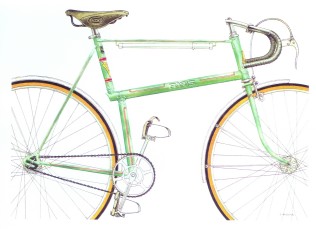 In 1950 as a 14 year old, I attended Luton Technical School, some 30 miles north of London, England.
In 1950 as a 14 year old, I attended Luton Technical School, some 30 miles north of London, England.
Adjacent to that school was a Technical College for older engineering students. Many of these students were racing cyclists and would leave their bikes in the bicycle rack in the school yard.
Lunch time would find me scrutinizing every fine detail of these bikes; it was the beginning of love affair with the bicycle that ultimately shaped my life, and lead to a career as a framebuilder.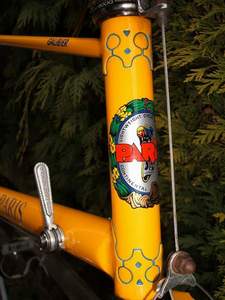 One of the most unusual and eye-catching bikes was the Paris “Galibier” model. Paris was the brand name of London framebuilder, Harry “Spanner” Rensch. His last name sounded like Wrench, hence the nickname “Spanner.” During WWII Rensch was an oxy-acetylene welder in London’s shipyards.
One of the most unusual and eye-catching bikes was the Paris “Galibier” model. Paris was the brand name of London framebuilder, Harry “Spanner” Rensch. His last name sounded like Wrench, hence the nickname “Spanner.” During WWII Rensch was an oxy-acetylene welder in London’s shipyards.
Paris Cycles started during the war in 1943. Harry probably chose the name Paris rather than use his own German sounding name, because of obvious wartime anti-German feeling, especially after the London Blitz.
He used a “Bi-laminated” construction for his frames, that is a sleeve brazed over the ends of the tubes, and the actual joint then filet brazed. Referred to as “Bronze Welding” in the Paris literature.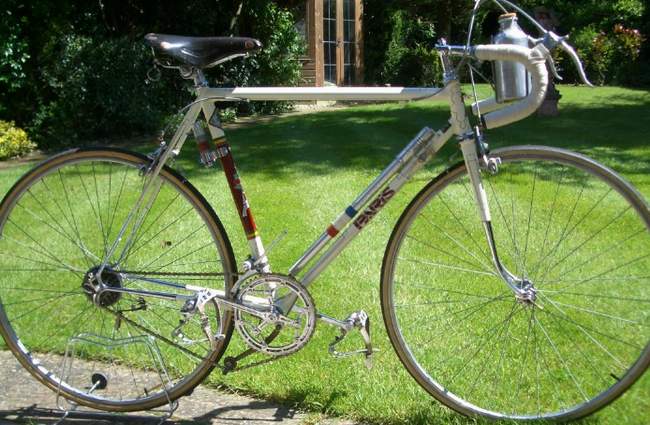
Beside the Galibier model, Harry Rensch also built conventionally designed frames. The most popular of which was the “Tour de France” model. (Click on picture above for a larger image.)
Paris frames often sported very flashy paint jobs, especially for that time. I remember red, white, and blue fade paint for example. There was a large Eiffel Tower decal on the seat tube, and the Paris name was stenciled on the down tube. 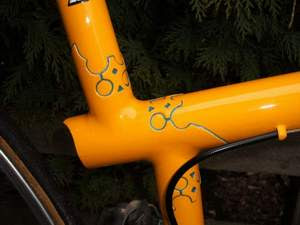 Ever since the introduction of the Galibier, and to this day, many a fierce argument has been held over this style guru’s dream machine. Is it just a style gimmick or is there real merit in this design?
Ever since the introduction of the Galibier, and to this day, many a fierce argument has been held over this style guru’s dream machine. Is it just a style gimmick or is there real merit in this design?
I never rode a Galibier, but I will say this, a bicycle frame twists as it is being ridden, about a line from the head tube to the rear dropout. So placing a single large tube along this line, (Or there abouts.) does have merit. The seat tube is also split to form an interesting cantilever design.
One thing cannot be denied is the superb craftsmanship of Harry Rensch. Like many artists before and since, Rensch was not a good businessman. Paris Cycles was always plagued with financial problems, and lasted just 10 years, closing their doors in 1953. Harry Rensch never returned to the bicycle business and died in 1984. The Galibier is his legacy. 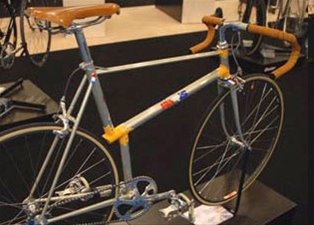
In recent years Condor Cycles in London bought the rights to the Paris name and are reproducing the Galibier model. (Picture above.)
Pictures from Classic Lightweights, UK
What to wear
 Fri, April 25, 2008
Fri, April 25, 2008 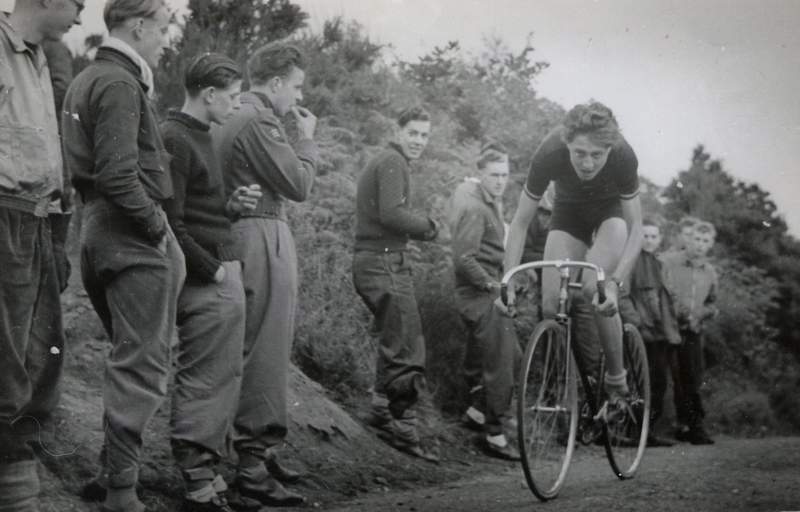
The picture above is from 1952; the year I started racing and riding seriously. The photo taken at a British Hill Climb; typically an end of season event taking place around October when temperatures were falling slightly.
Notice what the spectators are wearing; regular everyday clothes. (Click on the picture for a larger image.) These cyclists probably rode a considerable distance to the event; the only special equipment is the cycling shoes. Cords or heavier tweeds were popular in the colder months, being warm, comfortable, and hard wearing.
The person in the center is wearing jeans; he is probably a newcomer to the sport and would soon be advised, or figure out for himself that jeans were neither warm or comfortable. The thing is these are regular pants or trousers, worn in conjunction with bicycle clips to keep the bottoms from being caught in the chain.
On the upper body you will notice a mixture of sweaters and light jackets. I always wore a woolen undershirt next to my skin, wool stayed warm even when wet from sweat or outside elements. Often when setting out on a ride in the early morning hours, I would place a sheet of newspaper under my top sweater, to keep the cold wind off my chest. Later as the day warmed up, this was discarded.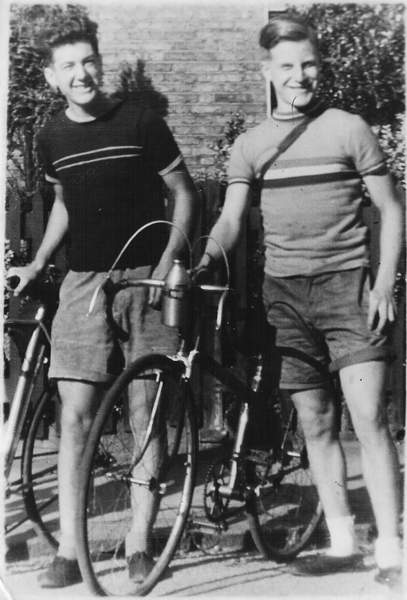 In the summer everyone wore regular shorts. (Picture left.) Racing clothes were made out of wool, they were expensive, needed to be hand washed, and took forever to dry. You could not throw them in the drier, or they would become matted and shrink.
In the summer everyone wore regular shorts. (Picture left.) Racing clothes were made out of wool, they were expensive, needed to be hand washed, and took forever to dry. You could not throw them in the drier, or they would become matted and shrink.
No one wore racing gear on a training ride. I do remember that when I did put these clothes on to race, they felt so comfortable and unrestrictive that I automatically rode faster.
The shorts had a real chamois leather insert inside, and I would smear a handful of Vaseline on it before a race. It felt extremely weird for about the first minute, but then kept me comfortable throughout the race, with zero chaffing. 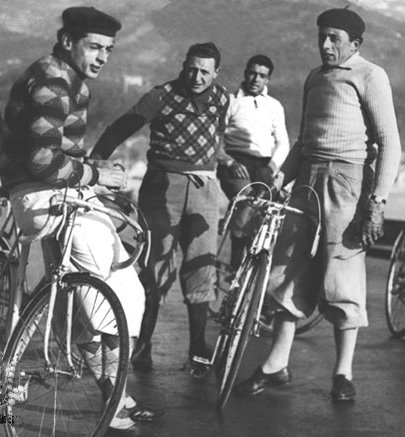 Even the pros did not wear racing gear for training rides. The picture above is of Fausto Coppi (Left.) with his brother Serse. (Right.) and a few other riders about to set out on a training ride.
Even the pros did not wear racing gear for training rides. The picture above is of Fausto Coppi (Left.) with his brother Serse. (Right.) and a few other riders about to set out on a training ride.
The trousers they are wearing would be specially made for cycling, but they are styled after regular street clothes with the exception that they fit just below the knee, and are worn in conjunction with knee length socks. On the top they are wearing a variety of woolen sweaters.
My mother was an expert at sewing, and I would take an old pair of trousers, and have her cut them off just below the knee. She would sew some wide elastic on the bottom to fit under my knee. The material cut from the bottom of the leg, she would make a double seat, which added comfort and made them wear longer.
By the 1970s, proper cycling clothes were available, but there were training clothes and racing clothes. Now it has become acceptable to train or simply ride for pleasure in racing gear.
I would not dress up in Lycra for a short trip to the post-office or store, but if I am riding for an hour or more, I love it and would not go back to wearing regular clothes for a long ride. The modern clothes are so comfortable, and the great thing is, I can throw the shorts and jersey in the washing machine, they are almost dry after the spin cycle, and air dry in a few hours.
However, in the 1950s we rode a hundred plus miles in a day in regular clothes so we proved that it can be done. You don’t have to wear special clothes to enjoy cycling, it is a personal choice; wear what you feel comfortable in.
Having said that; if you were invited to a formal dinner where everyone wore a tuxedo and black tie, you would look out of place if you showed up in casual clothes. Maybe you are thick-skinned enough that it wouldn’t bother you, but other guests would feel uncomfortable. The same would have been true if someone had shown up on a 1950s Club Run wearing racing gear.
It would also be the same today if I showed up dressed in street clothes, 1950s style for a ride with a group all wearing Lycra and helmets. Even if I was fit enough to stay with the group, some in the group would feel uncomfortable.
I know there will be others who disagree with me on this one; I can just hear the comments on “elitism.” We live in a social structure, and I feel that although we ultimately wear and do as we please, we do have a certain obligation not to offend or make others in our immediate peer group feel uncomfortable.
I use the term “immediate peer group,” because it seems when we wear Lycra we offend Joe Public, and that is not my problem, I will conform within limitations. Where Joe Public is concerned the “Gay Lycra outfits,” is just an expression of their contempt for the fact that we are on the road.
I remember in the 1950s, all the stuff you would normally carry in the rear pockets of your jersey, we carried in a small canvas bag called a Musette bag. (Tools, food, money, batteries for lights, etc.) I remember the general public, even those who used a bicycle for transport, would always ask, “What do you carry in those stupid little bags?”
Drivers delayed briefly by a group of cyclists wearing regular street clothes, the group I’m sure would be labeled, “Leftist, hippy, tree-huggers;” you can’t win that one.
Imagine the confusion that would be caused by a group or older gentlemen cyclists, dressed as the Italian Pro group above. How would they be labeled; “Old Poofters on Bikes,” maybe?
Whatever you do, don’t let the clothes you feel comfortable wearing, stop you from riding a bike.
Pictures are from Classic Lightweights, UK.
and Fausto Coppi, It.
Classic Dutch Bicycle Pictures
 Fri, April 11, 2008
Fri, April 11, 2008  I found these wonderful classic Dutch bicycle photos from collector Andre Koopman.
I found these wonderful classic Dutch bicycle photos from collector Andre Koopman. It is a mixture of photographs of this collector's bicycles, plus prints made from the old original glass plate negatives, some dating back to the late 1800s. These came from the Fongers factory, a Dutch bicycle manufacturer.
It is a mixture of photographs of this collector's bicycles, plus prints made from the old original glass plate negatives, some dating back to the late 1800s. These came from the Fongers factory, a Dutch bicycle manufacturer.
One of my favorite set of pictures is of a Gazelle bicycle; (Top picture.) it comes with a pretty amazing story that goes like this:
In 1939, a man buys a new bicycle. Soon after WWII breaks out, and with the impending invasion of Holland, man hides new bike in attic. Soon after man becomes sick and dies. Bike remains in attic for the next 64 years.
The unused bicycle was discovered in 2003 and bought by this collector. Even the original Gazelle tires were still good. The handlebars have a celluloid covering; yes, celluloid the stuff they used to make movie film, and was a forerunner of plastic.
Even the original Gazelle tires were still good. The handlebars have a celluloid covering; yes, celluloid the stuff they used to make movie film, and was a forerunner of plastic.
The bike has dynamo lighting; the wiring has rubber insulation with a woven cotton outer casing.
The bike also has a leather dress guard, and a single front brake that consists of a rubber block that pushes down on the front tire.
Pictured below is another bike that caught my interest, and is also from WWII. It is a British made, BSA folding bike that British Paratroopers carried on their back when they parachuted into Holland during the war.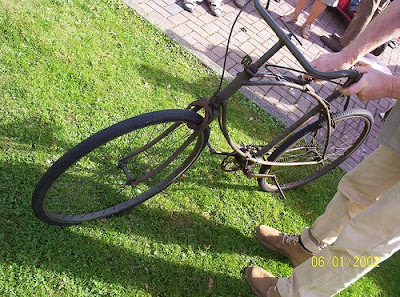 There must have been a large number of these left around the Dutch countryside after the initial drop.
There must have been a large number of these left around the Dutch countryside after the initial drop.
Another even older military bicycle is this 1898 Fongers. (Below.) Looking surprisingly like an Alex Moulton. 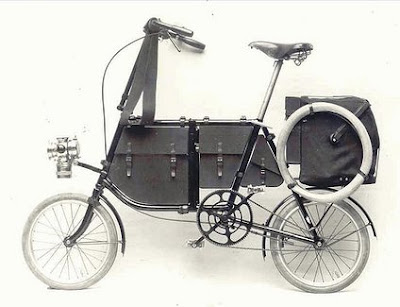 I am thinking that the picture got “flipped” and was printed backwards. I have never seen a bike with the chainwheel on the left side. There is no point in this as it would require a left-hand thread on the rear sprocket.
I am thinking that the picture got “flipped” and was printed backwards. I have never seen a bike with the chainwheel on the left side. There is no point in this as it would require a left-hand thread on the rear sprocket.
You can view the rest of the pictures here.
My thanks to Bakfiets en Meer, Netherlands who found the pictures first.

















